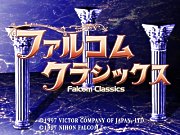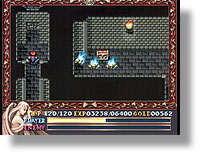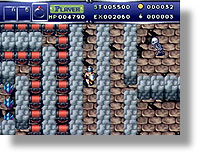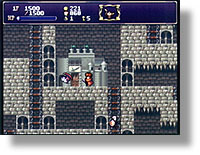|
|

|
PLATFORM
|
Saturn
|
BATTLE SYSTEM
|

|
INTERACTION
|

|
ORIGINALITY
|

|
STORY
|

|
MUSIC & SOUND
|

|
VISUALS
|

|
CHALLENGE
|
Easy
|
COMPLETION TIME
|
Less than 20 Hours
|
|
OVERALL

|
+ History lesson in Falcom RPGs
+ Ys I is a blast
- Dragon Slayer is downright weird
- Dragon Slayer and Xanadu lack Falcom's trademark music
- Archaic even by 1997's standards
|
Click here for scoring definitions
|
|
|
Falcom was instrumental to the development of RPG's in Japan during the 1980's, and thus is owed respect by all RPGamers save those who only play Western-developed games. As a retrospective, the company published Falcom Classics on the Sega Saturn in 1997. Never having attained a large English following and given the Saturn's lackluster market outside of Japan, this compilation remains a Japan-only item. Three games are included on the Falcom Classics collection, and the overall scores on the right are the best aggregate of the scores for these three I can compute. These games have been remade for the Saturn and are thus not emulations, which means these versions are exclusive and fortunately possess the ability to save at any time. Each game is very different and must be treated separately, in the order I played them.
I)Ys I: Ancient Ys Vanished Omens
The original Ys has been remade many times over the years, yet its rendition here is touted as possibly the best. Its story is minimal but effective: Adol runs around gathering the books of Ys, eventually pitting him against the evil Dark Fact who wants power that the books can grant him. Dark Fact appears only at the end of the game but with so little text his contribution is proportionately higher than that of many RPG final bosses'. What text exists in this game is in Japanese, but that does not affect the ease of play.
Ys games play with a disarmingly simple style. Adol wanders the landscape encountering enemies, and in action-RPG fashion he battles them on the field akin to an action game. Adol has no attack button however - simply ramming into the opposition causes damage. There is a trick to this; if Adol and the opponent collide head-on both will suffer damage (all other considerations being equal), but if Adol manages to side-swipe his opponent only the enemy will take damage. Enemies rapidly adjust their positions, making the player keep close attention to avoid suddenly taking hits. The system is fairly lenient with regard to hit detection, which is both a positive and negative: bosses in particular are incredibly good at landing multiple hits in quick succession. Adol has no recovery time whatsoever between hits, making close attention vital. Enemies bequeath experience and money to Adol upon their defeat, and sufficient experience earns a level-up. Level 10 is the maximum Adol can earn, which means each level-up makes a massive difference. Enemies that were doing enormous damage will suddenly do pathetic damage and hit far less often, while Adol will slaughter them with the greatest of ease. Standing stationary in the outdoors will recover Adol's HP, making regular opponents mostly a breeze.
 Whatever those blue flaming things are, Adol will teach them respect!
Whatever those blue flaming things are, Adol will teach them respect!
|
|
Inventory in Ys is simple enough. Though the effects of new equipment are not visible, the fact that more expensive and effective equipment is always arranged in a certain way makes it easy to pick the best inventory. Inventory items can be equipped and used with the A button, the only button used on the field save if running. Equipment makes an enormous difference, with the weaker sword, armor and shield being tantamount to suicide against later opponents. This version of the game features running by holding the B button and diagonal movement, though these are inexplicably unavailable during boss fights.
Regular opponents in Ys I are easy enough to deal with most of the time. Challenge comes later in the game from certain bosses, as items cannot be used and the inventory cannot be changed once a boss is encountered. Dark Fact has a particularly nasty ability wherein he knocks out part of the usable area with every hit, though he is not the only challenging boss late in the game. 'Late' is a relative term given that I finished in 3.5 hours and I am not known for rushing through games.
The visuals in Ys are unimpressive but nice enough, with the use of color being appreciated. These are mostly SNES-quality but look richer thanks to the Saturn's palette. This series is acclaimed for its music, and Ys I demonstrates why with a rocking soundtrack that is always entertaining. Short and sweet, this game does not overstay its welcome and is fun to play except when the player is trying to figure out an irritating boss's attack pattern.
II)Dragon Slayer
Dragon Slayer is both a pretty good 1981 movie featuring Peter MacNicol and Falcom's 1984 title that is apparently the first action-RPG. Its concepts are bizarre and alien to a newer audience, and thus need explication. Aside from a quick spot of Japanese text at the game's beginning, there is no story in the game. The few instances of writing in the game itself use English, oddly enough. The player starts the game as some nameless guy in a dungeon, and this guy for some reason wants to go Dragon Slaying. Accomplishing this will require quite a bit of work on the part of the player however, for this bonehead is poorly prepared to fight even the skeletons that wander the dungeon as its weakest opponents.
Combat is as basic as can be: the hero and an enemy try to occupy the same space, and they keep bumping into each other with both their HP decreasing until one dies. In order to do more than 10 damage at once (and all opponents have hundreds - usually thousands - of HP) the protagonist must acquire a sword. Once this is acquired damage dealt will increase massively. Enemies do bequeath experience, and experience seems to increase the HP maximum along with letting new spells be learned. There are no levels, at least not in any standard sense. Actual damage dealt does not increase based on experience however, and spells have a variety of navigation and maneuvering use but do not directly damage opponents.
To better battle adversaries the protagonist's house must be used. For some reason this hero lives in the dungeon, inside a house that is the same size he is. Taking gold coins to the house increases HP, more coming with a higher experience total. Taking a blue Power Stone to the house increases the hero's Strength, by 5000 each time. Slaying the dragon will require at least 300,000 Strength, probably more. It is here that the horrible inventory flaw of Dragon Slayer rears its head: only one item can be carried at a time. Though money and the little jars that allow spell usage are separate from the carried item, they cannot be picked up if the hero has an item in hand either. This means that each Power Stone must be individually carried back to the house, in a very tedious process. Other items include the ring which allows stone moving, the key which must be used on every treasure chest to open it (and there are hundreds of treasure chests), and the cross which makes enemies run away from the player. Each item stays on the ground until being picked up by the player, with the caveat that ghosts fly around the dungeon transplanting items randomly. Though it does not happen often, these ghosts are capable of grabbing the currently equipped item from the protagonist and taking it elsewhere. The item grabbing is not done even once the hero slays all three heads of the dragon: he must then grab the four things that the dragon was guarding and plop them into his house, which will suddenly have monster-spawning tombstones surrounding it. Only once those four things have been planted in the house will the Phase be over, at which point a new Phase begins and the whole thing begins again.
 The greatest spell to learn is Break, granting the power to smash through solid rock!
The greatest spell to learn is Break, granting the power to smash through solid rock!
|
|
Challenge in Dragon Slayer is of the aggravating sort, with much grinding being necessary. Simply getting stronger is no guarantee of success because certain enemies (accursed green monkeys!) can steal ALL strength, and certain other enemies can steal magic bottles and experience. Judicious saving and use of the Cross are vital to remove the risk of much work being undone with one move of an enemy. Otherwise the game is simple to beat: kill some enemies, plop lots of Power Stones into the house, then go off and kill the dragon. The levels are not random which removes any incentive to replay.
Visuals are unimpressive save for some truly bizarre enemies - walking computer monitors are unusual. There are no attack animations for anything however, and the dungeons look the same from Phase to Phase except for their layout. There is exactly one music track in this game, and it is sort of a New Age thing that is great for putting the player to sleep.
In the interest of full disclosure, I did not complete Dragon Slayer. Phase 5 supplied me with an insufficient number of Power Stones, which left me getting slaughtered by the dragon in that Phase. I opened every chest in that Phase and grabbed every Power Stone - there simply weren't enough. Such a case study illustrates exactly what about the game is off-putting; grinding is the only way to win. If the contents of chests are unfavorable, victory is impossible. Each Phase takes somewhere around an hour to 90 minutes to complete, but I cannot give an estimate of how long this game requires to complete when I do not know how many Phases there are.
III)Xanadu
A place where nobody dared to go
The love that we came to know
They call it Xanadu
And now
Open your eyes and see
What we have made is real
We are in Xanadu
That lyric reflects an odd aspect of Xanadu: I would prefer listening to Olivia Newton-John's #1 hit of the same name than its incredibly repetitive and boring music. Admittedly I do like Olivia Newton-John, but the music here is not good and the sound effects are worse. Crank up the music of one's choice while playing the game of some hero with no backstory exploring a big dungeon just because the king said to.
Having established that the aurals are terrible, the game itself warrants a description. At the beginning the king who seems to bid the hero off on this dungeon exploration gives 1000 gold, which can be used in increments of 100 to improve statistics. After exhausting the available funds the player must find a way into the dungeon, which can never be excaped from (though the only consequence of this is an inability to use the statistic increasing people in town again). On each floor of the dungeon various shops can be found by wandering around, and the shops sell weapons, armor, keys, magic, food, and two ways to restore HP. Churches are also present, into which the player must go to attain level-ups. A very annoying inventory aspect is the fact that weapons can only be sold at a weapon shop, spells can only be sold at a magic shop, etcetera.
 Why the weapons shop owner does not demonstrate his products right outside the door, I have no idea.
Why the weapons shop owner does not demonstrate his products right outside the door, I have no idea.
|
|
The game looks rather like a platforming title, and the hero can even jump, though it is an odd sort of floaty jump that comes from hitting Up instead of a button. Running around the dungeon are enemies, and upon collision the hero battles them. Battles take place from an overhead perspective and are basic in the extreme: the player collides with an enemy and both bump against each other. Lousy hit detection ensures that enemies will require lots of bumps to finally hit, and once an enemy is dead it drops a treasure chest. This treasure chest blocks action on the battlefield until the player bumps it open (this requires holding against the chest for a couple of seconds) and then physically grabs the item or money contained within. Both the chests and the things within them block movement, though this can be useful to prevent a mass of enemies attacking. Pressing C will use whatever spell is currently equipped, and spells not only allow ranged attacks but do not miss if aimed in the right direction. Weapon and spell experience is gained separately however, and using both is important because the door to the next floor of the dungeon will not open unless the player has reached a higher level. Irritating though it is, battle does not end until the player walks off the screen. Running away and leaving victoriously are accomplished the same way.
Food is consumed gradually as the player wanders around the dungeon. Consuming food automatically restores a bit of HP but if the food goes to 0 HP will be lost instead of gained. As many enemies drop food, it should not be necessary for the player to buy it. Keys are vital for opening doors that are in both the actual dungeon floors and inside their little mini-dungeons that contain valuable items. Keys are not dropped by enemies and must be bought from time to time, particularly since the mini-dungeons have the amazing knack of doors that unlock from one side and then need to be unlocked on the other side, requiring two keys. The currently equipped weapon, armor, shield, and magic gain experience of their own which makes them more effective at their assigned task. The concept of Karma must be mentioned; there are a few enemies that, if slain, will accrue Karma. Karma accrual is BAD because the church will refuse to grant level-ups, and the only way to reduce Karma is to find mini-dungeons with a black potion that cuts HP in half. These black potions do not reduce Karma by much, necessitating repeated trips.
Playing Xanadu will require somewhere from six to twelve hours I estimate, with ample exploration being possible. The game has a lot to find and do, with its archaic mechanics being the main stumbling block. Midway through the game challenge starts to ramp up, with enemies being able to eviscerate the hero in seconds thanks to the aforementioned shoddy hit detection allowing them to get in many powerful hits before the player can finally land any. Dead ends and many parts that require either more keys or mattocks to knock a hole in a floor become commonplace, and the only escape from a dead end is to use Z and transport onself back to the beginning of the first floor. The visuals here could have been replicated on an early 16-bit game; enemies and hero barely animate and the look of an unimpressive platformer is difficult to eradicate. As a positive to balance the negative, the each weapon and piece of equipment does look different when equipped.
End
Ys I is the most entertaining game here, without question. Xanadu can be engrossing for stretches until some aspect of its design becomes infuriating, while Dragon Slayer demonstrates monotony very well. Taken as a whole, Falcom Classics can probably be deemed more of a history lesson than an experience worthwhile to current RPGamers. It is interesting however, and its fairly cheap online prices make it worth investigating for anyone curious. The minimal knowledge of Japanese required to get through these games makes it all the easier to import.
Review Archives
|









